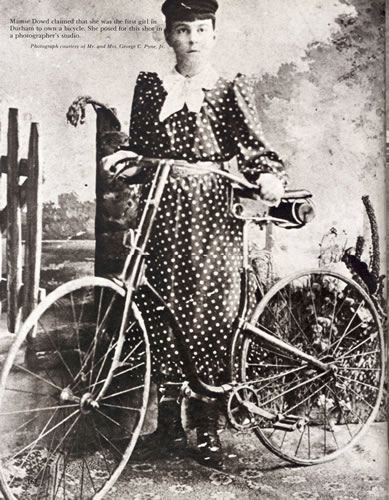Phillip Barron
The Herald Sun
March 6, 2008
For many, the nineties were a time of political advancement and financial success. The economy was doing well, failed policies from previous administrations were being turned back, manufacturing was on the increase, and progress was the buzz-word in board rooms and parlors.
This national excitement had something, more than a little, to do with the fact that the 1890s were also the height of the bicycle boom in the United States. In 1897 alone, approximately three hundred manufacturers in the US sold more two million bicycles, doubling production from the previous year.
The bicycle had been invented only thirty years earlier, and the constant stream of improvements to its design was a celebrated sign of progress. The bicycle’s adoption by women of the era made the bicycle literally and metaphorically a vehicle of social change.
In the 1930s, local newspaper columnist Wyatt T. Dixon wrote a few articles reflecting on bicycles’ popularity in 1887. B.L. Duke and Company’s furniture store rented high wheelers (the kind of bikes with a front wheel nearly as tall as the rider and much smaller rear wheel) for ten cents an hour. If you could afford it, renting bicycles and learning to ride the wobbly contraptions was a popular form of entertainment. Watching the cyclists fall off the bikes was equally entertaining for the crowd that formed every weekend.
Cycling, as Dixon reports it, was a man’s activity.
But, between 1887 and 1890, the number of cyclists in the US doubled. “The vast majority of new purchasers, many of whom were women, favored the new ‘safety bicycle,’” says David Herlihy in Bicycle: The History. The safety bicycle resembles what we now think of as a bicycle: two wheels of equal size with a chain-driven rear axle and lever-operated brakes. Its invention and mass production propelled cycling’s popularity.
In a photograph dating to roughly 1895, young Durhamite Mamie Dowd poses proudly with an Overman Victoria bicycle. The Victoria, Overman’s drop frame woman’s model, was a fixed gear safety bicycle outfitted with solid rubber tires. According to The Smithsonian Institution, “the drop frame bicycle was developed so that women could ride while wearing a long skirt. Its adoption greatly increased the popularity of the bicycle, and helped make cycling a popular sport for women, as well as, a means of transportation.”
Peter Zheutlin echoes the point in his biography of Annie Londonderry, the first woman to bicycle around the world; “a woman with a bicycle no longer had to depend on a man for transportation.”
No wonder then that in 1896 Susan B. Anthony said that bicycling had done more than anything else to emancipate women.
Dowd claimed to be the first woman in Durham to own a bicycle, though the authenticity of her claim is challenged by another photograph. In the second, two men and a woman pose in front of the Durham Electric Lighting Company in 1890. The two men stand in suits and top hats, while the woman wears a Victorian dress and hat. Notably, she sits astride a bicycle. The photo itself is a celebration of two major innovations of the time: the bicycle as well as Durham’s first electricity provider.

We know from accounts that conservatives of the time saw the bicycle as a symbol of unwelcome social change. While it was a celebrated technological innovation and an admirable source of amusement for men (and even boys), the bicycle’s role in women’s liberation kept it mired in controversy.
In his 1901 memoir, traditionalist James Battle Avirett reminisces antebellum values and derides the bicycle for ruining “the grace of woman’s attractive movement.” His comments parallel a June 6, 1895 article in Statesville’s daily, The Landmark, which notes that while “the number of women who ride bicycles is growing with great rapidity… even in the best and prettiest of costumes, no woman looks dignified while riding a bicycle.”
For conservatives, what was unwelcome about women cycling had as much to do with the resulting changes in women’s clothing as it had to do with these so-called ‘new women’ traveling on their own.
Zheutlin explains that “cycling required a more practical, rational form of dress, and the large billowing skirts and corsets started to give way to bloomers.”
In short, when it came to women, “cycling, and the dress reform that accompanied it, challenged traditional gender norms,” says Zheutlin.
Durham embraced the progress perhaps more easily than other cities its size. Women were working in tobacco factories as early as the 1880s, and local historian Jean Anderson notes that in 1896 “continuing efforts toward independence” led Durham women to create their own literary and social clubs, splintering away from male-dominated groups.

A third photograph from the era, this one also from 1895, shows a young boy and girl straddling bicycles in the driveway of the Morehead House on Duke Street.
Despite its high cost, the bicycle’s popularity transcended class. “Hundreds of thousands in the United States,” says Youth’s Companion magazine in the summer of 1896, “saved ‘every spare penny’ to buy a wheel,” and to the detriment of other businesses. As these photographs of turn of the century Durham show, bicycle fever transcended age and race as well.
Although it is unclear whether Dowd was the first woman in Durham to have a bike, later in life she did become the first judge of Durham’s Juvenile Court. Whether her bicycling days had anything to do with her later successful social reforms is up to you.

